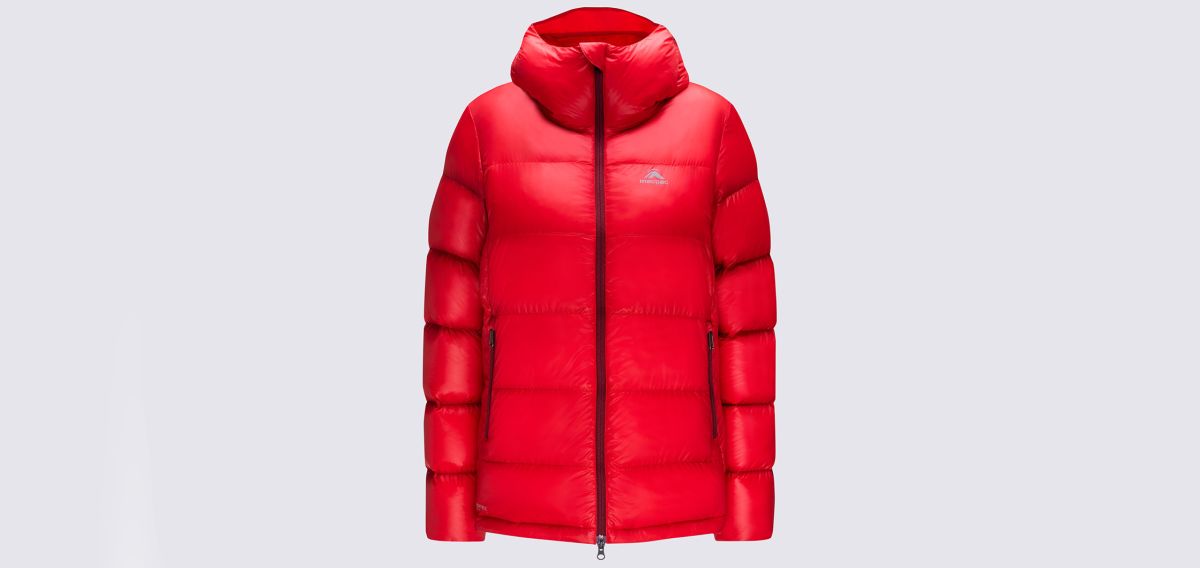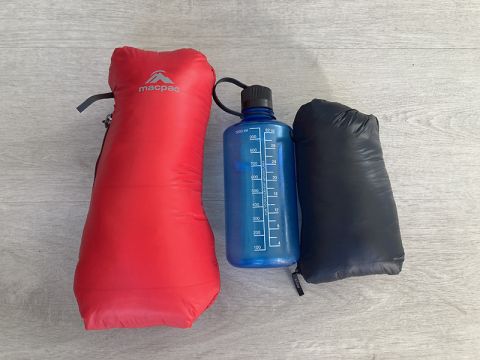
Macpac Women's Arrowsmith Down Jacket Review
Macpac Women's Arrowsmith Down Jacket
By Felicity Thomas
Reviewer: 167cm, 60kg
Size Reviewed: 10
Measured weight: 445g
Fill Power: 800 loft
Fill Weight: 187g
Features
You can read about all the features and specifications of this jacket on Macpac’s website here. One feature that stood out to me, in particular, was the size of the pockets. They are huge. You can easily fit a spare pair of winter gloves in there or even climbing shoes to warm them up on chilly winter days at the crag. There are also internal mesh pockets which can carry out the same function. Also, the hood fits comfortably over a climbing helmet but also fits just as well over your head with minimal adjustment required, which is a big plus.
Fit
Bless New Zealand clothes sizing. I am a chronic 'smed' when it comes to US or European sizing (IYKYK). This makes buying with out trying particularly tricky and I often end up with items that are too tight in some areas and too loose in others. But I can almost guarantee I am a size 10. This jacket holds true to this theory. It is looser fit than some size 10s, but it means you don’t have size up if you are worried about layering. I can comfortably fit a thick fleece underneath, or even a light down jacket for the seriously cold days. The only fit issue I have is the elasticated wrist loops are a little loose on my spindly wrists—leaving a gap for cold air creep in. This shouldn’t be a problem with a decent set of gloves on and my wrists are only a little thicker than a paper straw, so it might not be a problem for most people my size. I appreciate the longer fit which comes down over my backside when standing, it adds extra warmth and the reversible zip makes it no hassle to belay in.
TLDR: This garment is not a fitted puffer to wear to the pub but a cozy cocoon of down to stop you freezing on belay in the winter.
Weight and Packability
The stated weight of the Arrowsmith jacket in a size 10 is 450g on the Macpac website. My version weighed in at 455g. For those weight-weenies out there (myself included) nearly half a kilo or a block of butter is not a negligible amount. However, 187g of that weight is down, so the shell only weights 263g.
I have another down jacket which also has 800 loft, but only weighs 220g, fill included. The decision to throw my ultra-light down jacket in my pack, on a day when I am not sure I’ll need a down jacket or not, is much easier than causally throwing in the Arrowsmith jacket. However, these are different tools, for different jobs.
The zips on the Arrowsmith jacket feel 100% reliable and are easy to operate with winter gloves on. The same can’t be said for the ultra-light jacket—which has tiny plastic zips—and the outer feels like it has the integrity of a compostable rubbish bag to get it down to that almost invisible weight. The Arrowsmith outer is light—only 263g remember—but the Pertex shell does seem to add some durability. I will however be treating it carefully around sharp edges (shed doors included, which ate my last heavy down jacket) and pointy things.
In terms of packability, the reversible pocket on the Arrowsmith is impressive. I wasn’t sure how all that jacket was going to fit in—but it does! I know some people might prefer not to stuff their down jacket into a stuff sack or pocket due to the weird bulky shape jackets can turn into when compressed and which become hard to pack efficiently. However, I prefer to pack my jacket down on trips when I am on the move constantly (e.g. ski touring) so I don’t expect to be getting it out often or/and I have sharps in my bag which I desperately want to keep way from that layer. If I am just winter cragging, it will just get stuffed in amongst my other belongings.

As you can see in the photo the Arrowsmith has significantly more bulk than my ultra-light down jacket and takes up probably 1.5 times the space of a 1L Nalgene in your bag. But all those feathers gotta go somewhere right? Which leads us right in to the next section… warmth.
TLDR: It’s not the lightest down jacket around but it has 187g of feathers and packs down well for the amount of insulation it provides.
Warmth
In one word: toasty. The sort of jacket you can wear when you are on belay on a winter’s day, in the shade, and don’t need to shiver yourself warm. The sort of jacket that makes lunch breaks while ski touring a pleasant experience, rather than one to be rushed through. The sort of jacket where you can be happily out of your sleeping bag past dusk on a winter camping trip.
It’s the warmest jacket I own and will become part of a layer packing strategy for late-autumn to spring trips for me. Although in New Zealand it can snow in December, so it really could come in handy all year round. I have also been wearing it to work on frosty Otago winter mornings and at the crag.
TLDR: Warmest layer for the coldest days.
Sustainability
The jacket is PFC Free, Responsible Down Standard (RDS) certified, and made from a recycled nylon outer.
So it ticks all the boxes on the sustainability side and it’s encouraging to see Macpac putting such a focus on sustainability and considering the impacts within their supply chain. I will point out that the recycled nylon is 'currently sourced from pre-consumer industrial waste'. Which is something a lot of companies tend to hide in the fine print when it comes to recycled nylon. This means that it is likely from off-cuts of fabrics or something similar, rather than from post-consumer products i.e. it isn’t stopping your old nylon garment going to landfill.
I am sure there are a number of practical reasons for this and I am not an expert in recycled materials and materials sourcing, but part of my day job as an environmental engineer is to be skeptical about claims such as these. I have seen countless other examples where the demand for something that looks good from an environmental perspective creates perverse outcomes (if you want to be depressed look into the 'used cooking oil' sold for biofuel). In this case, the demand for 'recycled fabrics' could be incentivising companies to not reduce waste from offcuts—as it can now be sold as a valuable commodity to companies wanting to be able to label their materials 'recycled'. But this as broader issue with the clothing industry, sourcing marketing and consumerism.
Macpac do provide extensive guidance on how to best care for the Arrowsmith jacket and they offer a repair service for all garments. Following their recommendations to keep your jacket going stronger for longer and using their repair services when necessary is one of the most impactful things you can do for the sustainability of this product.
TLDR: It is certified to the highest environmental standards, but consumerism is inherently bad for the environment.
Use Cases
So I mentioned earlier I have an ultra-light down jacket as well as this jacket now. When will I be reaching for which?
I can tell you where I won’t be taking the Arrowsmith jacket. I won’t be taking is as my emergency layer on a long trail run.
I will however be taking it:
- Autumn/winter/spring cragging, in particular, on shady aspects.
- Ski touring/mountaineering especially in the winter and early spring, or when temps are forecast to be low, or winds high, and glacier trips when we are staying above 2000m.
- Ice climbing.
- Hiking when I am not concerned about a bit of extra weight and want to have a relaxing lunch break instead of getting cold.
- On overnight tramps and camping when the temps are expected to be around or below 5 degrees.
- To work on frosty Otago mornings.
There might be some spring ski touring trips where I feel like light and not-as-slow is more appropriate, especially when trying to juggle all the things I want to fit in a 30L day bag. But I’ve been really impressed with my few outings in the jacket so far and can’t wait for the snow to fall so I can test it out further.
TLDR: The use case is not getting cold whatever activity you are doing.
Too Long Didn’t Read Summary:
- This garment is not a fitted puffer to wear to the pub but a cozy cocoon of down to stop you freezing on belay in the winter.
- It’s not the lightest down jacket around, but it has 187g of feathers and packs down well for the amount of insulation it provides.
- It is super warm and seems like it will handle any conditions New Zealand will throw at it.
- It is certified to the highest environmental standards, but consumerism is inherently bad for the environment
- The best use case I see is not getting cold whatever activity you are doing.
